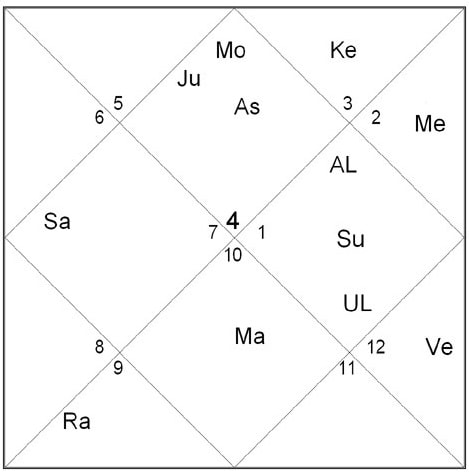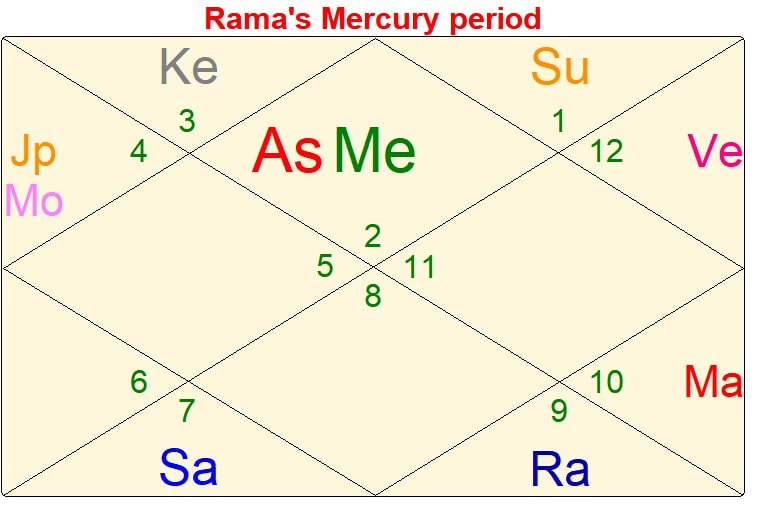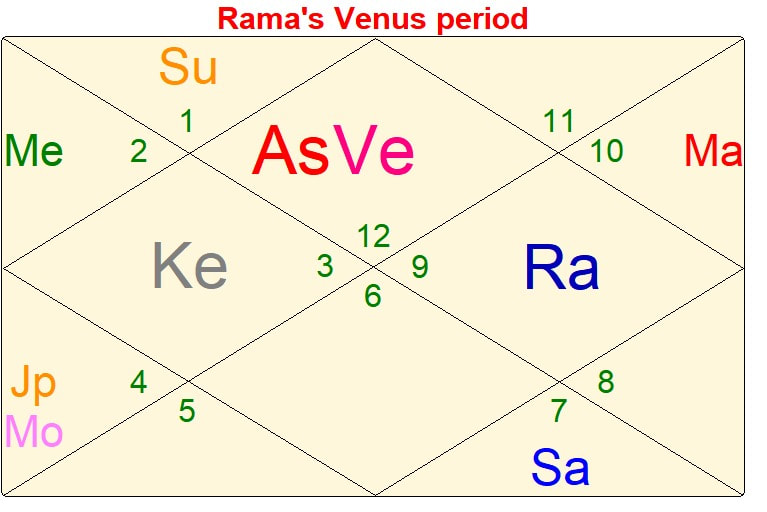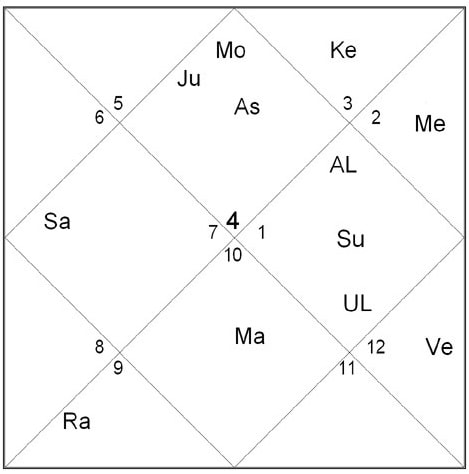|
I am a jyotishi, so when I attended an Indinanliterary festival today that is largely centered on the enigma of Sita in the Ramayana, I immediately thought of Rama's Jyotish chart.
There is much to process here. Indeed, I believe the whole of the multi-tome epic of the Ramayana is contained in this square, but I want to center your attention on the seventh house for Rama, locus of spouse. How does it make sense for Rama to have an exalted Mars in His house of spouse? The answer is that it does not, if we start and end with the idea that Sita is meek, submissive, subservient, and most critically, only some kind of victim of Dharma. Let me take you on a bit of a journey, a short Sitayana in Jyotish, if you will. Let's start at the beginning, Rama's Saturn mahadasha, for according to Vasistha's Yoga, Rama as a youth and not yet a God was fairly morose.
I propose that He was born in early Saturn or very late Jupiter mahadasha. This would be consistent with an early Pushyami or late Punarvasu Moon nakshatra, for of course He would be be born with Moon close to 3 degrees, 20 minutes of Cancer, possibly the finest point of the zodiac and key calculation point for the yogi graha. The late Punarvasu is especially attractive, as a Moon there would be vargottama and pushkar. Also, its indication of "good again" is particularly relevant to a God who had to regain a kingdom and his spouse.
Therefore, as a youth of 16 to 18 or so years of age, Rama was still in Saturn mahadasha. His life at the time of meeting Sita thus can be seen by rotating the above chart to have a lagna with the mahadasha lord Saturn in the ascendant.
All of the mahapurusha yogas that were in the original chart are still there, but there is something wrong. The dig balas are off. Actually, the directions are opposite their places of strength. Only from Sita's position in the seventh are all of the mahapurushas in dig bala. Only from Her is everything in its right place.
More locally relevant to the topic of Sita at the time of meeting, Her own royalty must have greatly informed Shri Ram's perspective of Her, for there is that incredibly strong Sun in the seventh house. The arudha, or appearance from afar, of that seventh house takes us to the beautiful Jupiter and Moon perfect hamsa (swan) yoga in Cancer. That must describe what She seemed like to Rama at the time and to all else who gazed upon Her. Also of note is Rahu in Dhanus, Saggitarius, and it was through dhanurved or the art of archery that Rama impressed Sita's father enough to win Her hand, for that Saggitarius represents both the third house of martial arts for Rama and the father of Sita, being nine houses (father) from the seventh (spouse). The fourteen year exile must have happened around the start of the following Mercury mahadasha. Here is Rama's chart with Mercury in lagna.
Note all of the natural planets in dusthanas, except for Mercury rising and the exalted Mars in the place of high Dharma in the ninth house. Sita, as represented by the seventh house, now has Scorpio as her representation.
Ten years along in the exile and ten years along in the Mercury mahadasha, Sita was abducted. This would be in Mercury/Rahu bhukti for Shri Rama. To see all of the dense material of storyline that happened during the Mercury dasha, it makes some sense to see the more subtle details through the subtlety of the bhuktis. Thus, if we look at Rama's chart with Rahu rising, we should be able to see details of that terrible year while Sita was abducted.
Rama's hard and hard-earned place in society while fighting for Sita in exile is seen in the eleventh house of society where there is an exalted Saturn. The younger brother as interim king may be seen by the tenth house being Virgo, the original third house of younger brother for Rama.
Here one can immediately see the loss by abduction of Sita by seeing the karaka (symbol) of loss, Ketu, in the seventh house. The well-educated "mahabrahmin" of Ravana as enemy of Shri Rama is evident by the sixth house (representing enemy) where the lord of the seventh house (Sita) has gone. Assistance by Hanuman and other exemplary kshatriyas is clear in many ways. Mars exalted in the second house, aspects into and enlivens the purva punya fifth house space of past life kingliness of Shri Ram which lords the royal, regal ninth which Mars also aspects into. Mercury/Rahu bhukti would naturally segue to Mercury/Jupiter, and the Jupiter in lagna brings us back to Rama's original chart. All was returned to rectitude in that period. Then Mercury/Saturn naturally follows as the last bhukti in the Mercury period. Here is its chart.
One can see the return of Shri Rama as king, for his natal lagna now resides in the tenth house. Shortly thereafter, though, a whole new mahadasha begins for Rama, and by extension, for everyone else, the Ketu period of release or letting go. It lasts for seven years, and here is its chart for Shri Rama.
With the kingdom returned (eleventh house) and evidently, much comfort (second house), it does seem though that upon the second exile, Shri Rama pined for Sita with His whole mind and His whole speech as the lord of the seventh is now lorded by an exalted Jupiter conjoined Moon (mind) in the second house of speech. Much hardship must have been visited upon the twin sons of Rama and Sita as Saturn is in the fifth house of children, even as the sons were under the aegis of Vasistha, a rishi often represented by Saturn.
What would have had to happen next was a period of twenty years known as Venus mahadasha. Here is its chart.
I believe it is early in this period that Sita performed mahasamadhi by returning to the Earth Mother. The sons would be about seven years old, old enough to return to their father and enter into formal education. Note the beatific hamsa yoga with two graha now in the fifth house of children for Shri Ram.
Rahu is in the tenth house which is the fourth house relative to the seventh house of Sita, and She must have been wanting (Rahu) to return to Her and our Earth Mother (fourth house to Her). That Her death was by a blaze of light, by Agni, can be seen by the eighth house (how we die) to the seventh (Sita) containing the exalted agni of the Sun. The death of Sita, or more exactly the return to Mother, is through righteous action as the lord of the seventh house has gone to its ninth. Her return to Earth Mother can also be considered as highly dharmic since the lord of the fourth house of Mother to Sita is Jupiter in that hamsa yoga in the eleventh to the seventh, thus consecrating Her place in society across the ages. All other graha except Saturn are in the bottom half of the chart relative to the seventh house of Sita, making me believe that Her actions were for love of Rama (Venus exalted in the seventh to Her) and indeed for all of us. Why did She die? In the most immediate sense, this can be seen above as the third house to Her, the enigmatic Scorpio. Thus, I used the word enigma in the title of this post. However, in the biggest sense, we can return to Rama's birth chart to see why She died.
For any of us, why we die can be seen in the third house, and the third house to Sita in the seventh is that exalted Venus in Pisces in the ninth house, also indicating the ultimate Dharma of Rama.
She died for love, love in the highest, most Piscean manner. So, who is Sita? By appearances only, the arudha of the seventh house is Saturn exalted whose fourth house contains exalted Mars. Mars often stands for parcels of earth, so this set of arudha significators does align with the most superficial take of Sita as a long suffering wife and child of the Earth mother, but that is only the view from afar. Looking deeper, in the above chart, the truth is that She IS exalted Mars. Mother Sita IS Mother Earth, and from Her self-sacrifice arose the King of Kings and His kingdom. Mars aspects into and creates the exaltation space of the Sun, the king and His lineage, in the tenth house, a kingdom that some say lasted for millions of years and still exists today, a kingdom that places all things rightly, for from that Sun's solar or soular point of view, all of the mahapurusha yogas finally achieve directional strength. (Note also that the Sun period follows from the Venus period within which the above analysis suggests that Sita reached mahasamaddhi.) Through much trial and self-sacrifice, Sita may be said to be somewhat like that other incorporated godhead Who created a heavenly kingdom for all time on Earth via divine perfect Piscean love, Jesus Christ. At the very least, I welcome people to consider using these Jyotish elements to the Ramayana to understand better the enigma of Sita and with Her, the grand, beautiful and yes, enigmatic necessity of love, of family, and of Dharma.
P.S. The Indians at the conference gave permission for the imaginings represented here.
Also, please forgive the lack of formal transliteration of Sanskrit in this post. The evening wears on, and I felt it was more important to post this at all, compared to perhaps not posting it but doing that in a formal way!
1 Comment
Eric Goldman
11/2/2019 10:50:59 pm
Wow. Soon I will understand and follow beyond the first 4-5 paragraphs!
Reply
Your comment will be posted after it is approved.
Leave a Reply. |
ARTICLESAuthorRenay Oshop - teacher, searcher, researcher, immerser, rejoicer, enjoying the interstices between Twitter, Facebook, and journals. Categories
All
Archives
September 2023
|
© 2008–2024 Renay Oshop AyurAstro®









 RSS Feed
RSS Feed